三聚氰胺树脂 MSDS
- 格式:pdf
- 大小:150.72 KB
- 文档页数:5

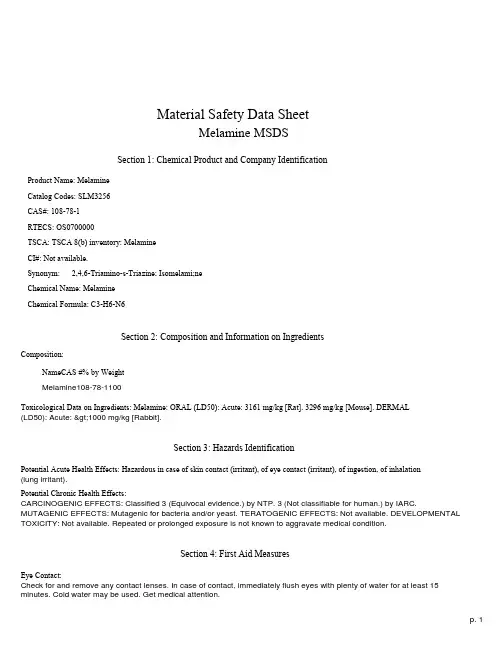
Material Safety Data SheetMelamine MSDSSection 1: Chemical Product and Company IdentificationProduct Name: MelamineCatalog Codes: SLM3256CAS#: 108-78-1RTECS: OS0700000TSCA: TSCA 8(b) inventory: MelamineCI#: Not available.Synonym: 2,4,6-Triamino-s-Triazine; Isomelami;neChemical Name: MelamineChemical Formula: C3-H6-N6Section 2: Composition and Information on IngredientsComposition:NameCAS #% by WeightMelamine108-78-1100Toxicological Data on Ingredients: Melamine: ORAL (LD50): Acute: 3161 mg/kg [Rat]. 3296 mg/kg [Mouse]. DERMAL(LD50): Acute: >1000 mg/kg [Rabbit].Section 3: Hazards IdentificationPotential Acute Health Effects: Hazardous in case of skin contact (irritant), of eye contact (irritant), of ingestion, of inhalation(lung irritant).Potential Chronic Health Effects:CARCINOGENIC EFFECTS: Classified 3 (Equivocal evidence.) by NTP. 3 (Not classifiable for human.) by IARC. MUTAGENIC EFFECTS: Mutagenic for bacteria and/or yeast. TERATOGENIC EFFECTS: Not available. DEVELOPMENTAL TOXICITY: Not available. Repeated or prolonged exposure is not known to aggravate medical condition.Section 4: First Aid MeasuresEye Contact:Check for and remove any contact lenses. In case of contact, immediately flush eyes with plenty of water for at least 15 minutes. Cold water may be used. Get medical attention.Skin Contact:In case of contact, immediately flush skin with plenty of water. Cover the irritated skin with an emollient. Remove contaminated clothing and shoes. Cold water may be used.Wash clothing before reuse. Thoroughly clean shoes before reuse. Get medical attention.Serious Skin Contact:Wash with a disinfectant soap and cover the contaminated skin with an anti-bacterial cream. Seek immediate medical attention.Inhalation:If inhaled, remove to fresh air. If not breathing, give artificial respiration. If breathing is difficult, give oxygen. Get medical attention.Serious Inhalation: Not available.Ingestion:Do NOT induce vomiting unless directed to do so by medical personnel. Never give anything by mouth to an unconscious person. Loosen tight clothing such as a collar, tie, belt or waistband. Get medical attention if symptoms appear.Serious Ingestion: Not available.Section 5: Fire and Explosion DataFlammability of the Product: May be combustible at high temperature.Auto-Ignition Temperature: Not available.Flash Points: CLOSED CUP: Higher than 93.3°C (200°F).Flammable Limits: Not available.Products of Combustion:These products are carbon oxides (CO, CO2), nitrogen oxides (NO, NO2...), cyanide fumes, irritating and toxic fumes and gases.Fire Hazards in Presence of Various Substances: Slightly flammable to flammable in presence of heat.Explosion Hazards in Presence of Various Substances:Risks of explosion of the product in presence of mechanical impact: Not available. Risks of explosion of the product in presence of static discharge: Not available.Fire Fighting Media and Instructions:SMALL FIRE: Use DRY chemical powder. LARGE FIRE: Use water spray, fog or foam. Do not use water jet.Special Remarks on Fire Hazards: Not available.Special Remarks on Explosion Hazards: Not available.Section 6: Accidental Release MeasuresSmall Spill:Use appropriate tools to put the spilled solid in a convenient waste disposal container. Finish cleaning by spreading water on the contaminated surface and dispose of according to local and regional authority requirements.Large Spill:Use a shovel to put the material into a convenient waste disposal container. Finish cleaning by spreading water on the contaminated surface and allow to evacuate through the sanitary system.Section 7: Handling and StoragePrecautions:Keep locked up.. Keep away from heat. Keep away from sources of ignition. Empty containers pose a fire risk, evaporate the residue under a fume hood. Ground all equipment containing material. Do not ingest. Do not breathe dust. Wear suitable protective clothing. In case of insufficient ventilation, wear suitable respiratory equipment. If ingested, seek medical advice immediately and show the container or the label. Avoid contact with skin and eyes. Keep away from incompatibles such as oxidizing agents, acids.Storage: Keep container tightly closed. Keep container in a cool, well-ventilated area. Do not store above 23°C (73.4°F).Section 8: Exposure Controls/Personal ProtectionEngineering Controls:Use process enclosures, local exhaust ventilation, or other engineering controls to keep airborne levels below recommended exposure limits. If user operations generate dust, fume or mist, use ventilation to keep exposure to airborne contaminants below the exposure limit.Personal Protection:Splash goggles. Lab coat. Dust respirator. Be sure to use an approved/certified respirator or equivalent. Gloves.Personal Protection in Case of a Large Spill:Splash goggles. Full suit. Dust respirator. Boots. Gloves. A self contained breathing apparatus should be used to avoid inhalation of the product. Suggested protective clothing might not be sufficient; consult a specialist BEFORE handling this product.Exposure Limits: Not available.Section 9: Physical and Chemical PropertiesPhysical state and appearance: Solid. (Crystalline solid.)Odor: Not available.Taste: Not available.Molecular Weight: 126.12 g/moleColor: White.pH (1% soln/water): Not available.Boiling Point: Not available.Melting Point: <250°C (482°F)Critical Temperature: Not available.Specific Gravity: 1.573 (Water = 1)Vapor Pressure: Not applicable.Vapor Density: 4.34 (Air = 1)Volatility: Not available.Odor Threshold: Not available.Water/Oil Dist. Coeff.: Not available.Ionicity (in Water): Not available.Dispersion Properties: See solubility in water.Solubility:Partially soluble in cold water. Insoluble in diethyl ether.Section 10: Stability and Reactivity DataStability: The product is stable.Instability Temperature: Not available.Conditions of Instability: Dust generation, excess heat, incompatible materials.Incompatibility with various substances: Reactive with oxidizing agents, acids.Corrosivity: Not available.Special Remarks on Reactivity: Not available.Special Remarks on Corrosivity: Not available.Polymerization: Will not occur.Section 11: Toxicological InformationRoutes of Entry: Inhalation. Ingestion.Toxicity to Animals:Acute oral toxicity (LD50): 3161 mg/kg [Rat]. Acute dermal toxicity (LD50): >1000 mg/kg [Rabbit].Chronic Effects on Humans:CARCINOGENIC EFFECTS: Classified 3 (Equivocal evidence.) by NTP. 3 (Not classifiable for human.) by IARC. MUTAGENIC EFFECTS: Mutagenic for bacteria and/or yeast.Other Toxic Effects on Humans: Hazardous in case of skin contact (irritant), of ingestion, of inhalation (lung irritant).Special Remarks on Toxicity to Animals: Not available.Special Remarks on Chronic Effects on Humans:May cause adverse reproductive effects (fertility, fetotoxicity), and may affect genetic material based on animal data. May also be tumorigenic (carcinogenic) based on animal data.Special Remarks on other Toxic Effects on Humans:Acute Potential Health Effects: Skin: May cause skin irritation. Eyes: May cause eye irritation. Inhalation: May cause irritation of the respiratory tract and affect respiration. May affect behavior and sense organs, liver and blood. Ingestion: May cause irritation of the digestive tract with nausea, vomiting and diarrhea. May affect the urinary system.Section 12: Ecological InformationEcotoxicity: Not available.BOD5 and COD: Not available.Products of Biodegradation:Possibly hazardous short term degradation products are not likely. However, long term degradation products may arise. Toxicity of the Products of Biodegradation: The products of degradation are less toxic than the product itself.Special Remarks on the Products of Biodegradation: Not available.Section 13: Disposal ConsiderationsWaste Disposal:Waste must be disposed of in accordance with federal, state and local environmental control regulations.Section 14: Transport InformationDOT Classification: Not a DOT controlled material (United States).Identification: Not applicable.Special Provisions for Transport: Not applicable.Section 15: Other Regulatory InformationFederal and State Regulations:Pennsylvania RTK: Melamine Massachusetts RTK: Melamine New Jersey: Melamine TSCA 8(b) inventory: MelamineOther Regulations: EINECS: This product is on the European Inventory of Existing Commercial Chemical Substances.Other Classifications:WHMIS (Canada): Not controlled under WHMIS (Canada).DSCL (EEC):R36/37/38- Irritating to eyes, respiratory system and skin. S24/25- Avoid contact with skin and eyes. S36/37/39- Wear suitable protective clothing, gloves and eye/face protection.HMIS (U.S.A.):Health Hazard: 2Fire Hazard: 1Reactivity: 0Personal Protection: ENational Fire Protection Association (U.S.A.):Health: 2Flammability: 1Reactivity: 0Specific hazard:Protective Equipment:Gloves. Lab coat. Dust respirator. Be sure to use an approved/certified respirator or equivalent. Splash goggles.Section 16: Other InformationReferences: Not available.Other Special Considerations: Not available.The information above is believed to be accurate and represents the best information currently available to us. However, wemake no warranty of merchantability or any other warranty, express or implied, with respect to such information, and we assumeno liability resulting from its use. Users should make their own investigations to determine the suitability of the information fortheir particular purposes.。
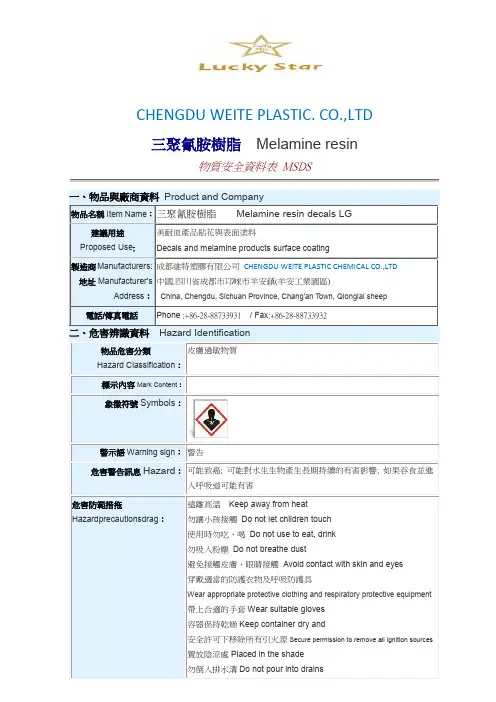
CHENGDU WEITE PLASTIC. CO.,LTD三聚氰胺樹脂Melamine resin物質安全資料表MSDS一、物品與廠商資料Product and Company物品名稱Item Name:三聚氰胺樹脂Melamine resin decals LG建議用途Proposed Use: 美耐皿產品貼花與表面塗料Decals and melamine products surface coating製造商Manufacturers:地址Manufacturer'sAddress:成都維特塑膠有限公司CHENGDU WEITE PLASTIC CHEMICAL CO.,LTD 中國.四川省成都市邛崍市羊安鎮(羊安工業園區)China, Chengdu, Sichuan Province, Chang'an Town, Qionglai sheep電話/傳真電話Phone :+86-28-88733931 / Fax:+86-28-88733932二、危害辨識資料Hazard Identification物品危害分類Hazard Classification:皮膚過敏物質標示內容Mark Content:象徵符號Symbols:警示語Warning sign:警告危害警告訊息Hazard:可能致癌; 可能對水生生物產生長期持續的有害影響; 如果吞食並進入呼吸道可能有害危害防範措拖Hazardprecautionsdrag:遠離高溫Keep away from heat勿讓小孩接觸Do not let children touch使用時勿吃、喝Do not use to eat, drink勿吸入粉塵Do not breathe dust避免接觸皮膚、眼睛接觸Avoid contact with skin and eyes穿戴適當的防護衣物及呼吸防護具Wear appropriate protective clothing and respiratory protective equipment 帶上合適的手套Wear suitable gloves容器保持乾燥Keep container dry and安全許可下移除所有引火源Secure permission to remove all ignition sources 置放陰涼處Placed in the shade勿倒入排水溝Do not pour into drains混合物Mixture:。
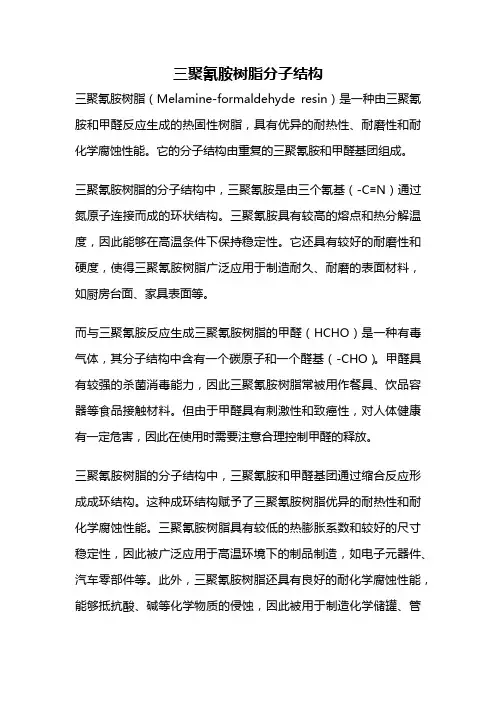
三聚氰胺树脂分子结构三聚氰胺树脂(Melamine-formaldehyde resin)是一种由三聚氰胺和甲醛反应生成的热固性树脂,具有优异的耐热性、耐磨性和耐化学腐蚀性能。
它的分子结构由重复的三聚氰胺和甲醛基团组成。
三聚氰胺树脂的分子结构中,三聚氰胺是由三个氰基(-C≡N)通过氮原子连接而成的环状结构。
三聚氰胺具有较高的熔点和热分解温度,因此能够在高温条件下保持稳定性。
它还具有较好的耐磨性和硬度,使得三聚氰胺树脂广泛应用于制造耐久、耐磨的表面材料,如厨房台面、家具表面等。
而与三聚氰胺反应生成三聚氰胺树脂的甲醛(HCHO)是一种有毒气体,其分子结构中含有一个碳原子和一个醛基(-CHO)。
甲醛具有较强的杀菌消毒能力,因此三聚氰胺树脂常被用作餐具、饮品容器等食品接触材料。
但由于甲醛具有刺激性和致癌性,对人体健康有一定危害,因此在使用时需要注意合理控制甲醛的释放。
三聚氰胺树脂的分子结构中,三聚氰胺和甲醛基团通过缩合反应形成成环结构。
这种成环结构赋予了三聚氰胺树脂优异的耐热性和耐化学腐蚀性能。
三聚氰胺树脂具有较低的热膨胀系数和较好的尺寸稳定性,因此被广泛应用于高温环境下的制品制造,如电子元器件、汽车零部件等。
此外,三聚氰胺树脂还具有良好的耐化学腐蚀性能,能够抵抗酸、碱等化学物质的侵蚀,因此被用于制造化学储罐、管道等设备。
除了优异的耐热性和耐化学腐蚀性能,三聚氰胺树脂还具有良好的机械性能和电绝缘性能。
它具有较高的强度和硬度,能够承受较大的外力和压力。
同时,三聚氰胺树脂具有良好的电绝缘性能,能够在高压、高温条件下保持稳定的绝缘性能,因此被广泛应用于电气领域,如电缆绝缘、电器外壳等。
三聚氰胺树脂是一种具有优异性能的热固性树脂。
它的分子结构由三聚氰胺和甲醛基团组成,具有耐热性、耐磨性、耐化学腐蚀性能、机械性能和电绝缘性能等特点。
这使得三聚氰胺树脂在多个领域得到广泛应用,如建筑、电子、化工等。
然而,由于甲醛的毒性和致癌性,使用三聚氰胺树脂制品时需要注意合理控制甲醛的释放,以保护人体健康。
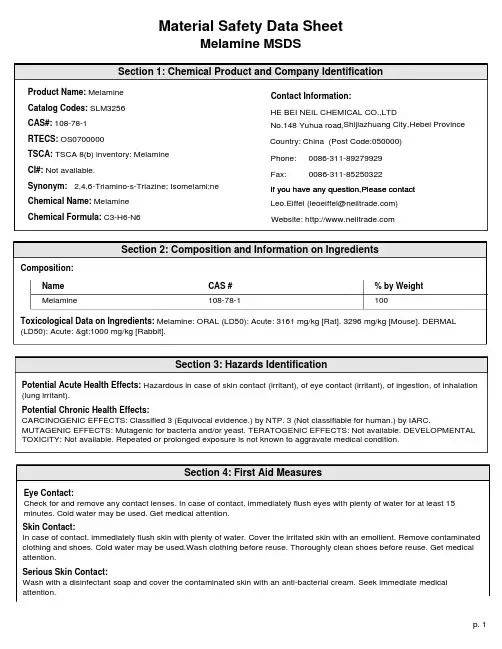
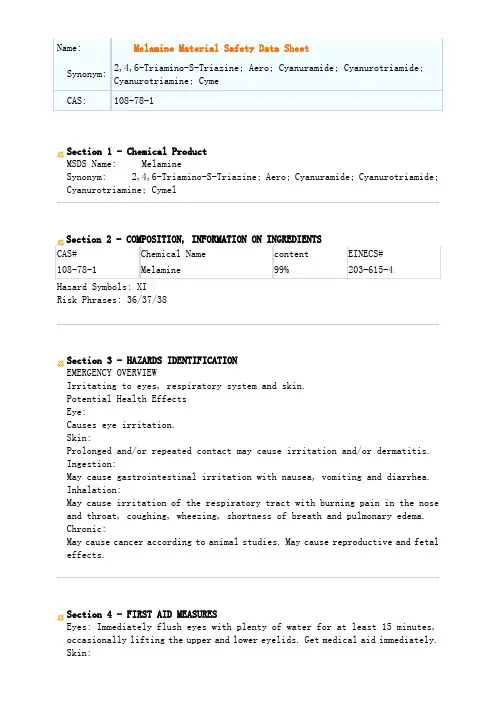
Name: Melamine Material Safety Data SheetSynonym: 2,4,6-Triamino-S-Triazine; Aero; Cyanuramide; Cyanurotriamide; Cyanurotriamine; CymeCAS: 108-78-1Section 1 - Chemical ProductMSDS Name: MelamineSynonym: 2,4,6-Triamino-S-Triazine; Aero; Cyanuramide; Cyanurotriamide; Cyanurotriamine; CymelSection 2 - COMPOSITION, INFORMATION ON INGREDIENTSCAS# Chemical Name content EINECS#108-78-1 Melamine 99% 203-615-4Hazard Symbols: XIRisk Phrases: 36/37/38Section 3 - HAZARDS IDENTIFICATIONEMERGENCY OVERVIEWIrritating to eyes, respiratory system and skin.Potential Health EffectsEye:Causes eye irritation.Skin:Prolonged and/or repeated contact may cause irritation and/or dermatitis. Ingestion:May cause gastrointestinal irritation with nausea, vomiting and diarrhea. Inhalation:May cause irritation of the respiratory tract with burning pain in the nose and throat, coughing, wheezing, shortness of breath and pulmonary edema. Chronic:May cause cancer according to animal studies. May cause reproductive and fetal effects.Section 4 - FIRST AID MEASURESEyes: Immediately flush eyes with plenty of water for at least 15 minutes, occasionally lifting the upper and lower eyelids. Get medical aid immediately. Skin:Immediately flush skin with plenty of soap and water for at least 15 minutes while removing contaminated clothing and shoes. Get medical aid if irritation develops or persists. Wash clothing before reuse.Ingestion:Do NOT induce vomiting. If victim is conscious and alert, give 2-4 cupfuls of milk or water. Never give anything by mouth to an unconscious person. Get medical aid immediately.Inhalation:Remove from exposure to fresh air immediately. If not breathing, give artificial respiration. If breathing is difficult, give oxygen.Get medical aid.Notes to Physician:Section 5 - FIRE FIGHTING MEASURESGeneral Information:As in any fire, wear a self-contained breathing apparatus in pressure-demand, MSHA/NIOSH (approved or equivalent), and full protective gear. During a fire, irritating and highly toxic gases may be generated by thermal decomposition or combustion. Vapors may be heavier than air. They can spread along the ground and collect in low or confined areas.Extinguishing Media:Use water spray, dry chemical, carbon dioxide, or chemical foam. Use agent most appropriate to extinguish fire.Section 6 - ACCIDENTAL RELEASE MEASURESGeneral Information: Use proper personal protective equipment as indicated in Section 8.Spills/Leaks:Wash area with soap and water. Clean up spills immediately, observing precautions in the Protective Equipment section. Sweep up, then place into a suitable container for disposal. Avoid generating dusty conditions. Provide ventilation.Section 7 - HANDLING and STORAGEHandling:Wash thoroughly after handling. Use with adequate ventilation. Avoid contact with eyes, skin, and clothing. Keep container tightly closed.Avoid ingestion and inhalation. Wash clothing before reuse.Storage:Store in a cool, dry place. Keep container closed when not in use.Section 8 - EXPOSURE CONTROLS, PERSONAL PROTECTIONEngineering Controls:Facilities storing or utilizing this material should be equipped with an eyewash facility and a safety shower. Use adequate general or local exhaust ventilation to keep airborne concentrations below the permissible exposure limits.Personal Protective Equipment Eyes: Wear appropriate protective eyeglasses or chemical safety goggles as described by OSHA's eye and face protection regulations in 29 CFR 1910.133 or European Standard EN166.Skin:Wear appropriate gloves to prevent skin exposure.Clothing:Wear appropriate protective clothing to prevent skin exposure. Respirators:Follow the OSHA respirator regulations found in 29CFR 1910.134 or European Standard EN 149. Always use a NIOSH or European Standard EN 149 approved respirator when necessary.Section 9 - PHYSICAL AND CHEMICAL PROPERTIESPhysical State: SolidAppearance: whiteOdor: None reported.pH: Not available.Vapor Pressure: 50 mm Hg @ 315 CViscosity: Not available.Boiling Point: sublimesFreezing/Melting Point: < 250 deg CAutoignition Temperature: Not available.Flash Point: Not available.Explosion Limits, lower: Not available.Explosion Limits, upper: Not available.Decomposition Temperature:Solubility in water: Slightly soluble in water.Specific Gravity/Density: 1.573 @ 250CMolecular Formula: C3H6N6Molecular Weight: 126.0822Section 10 - STABILITY AND REACTIVITYChemical Stability:Stable under normal temperatures and pressures.Conditions to Avoid:Incompatible materials, dust generation, excess heat, strong oxidants. Incompatibilities with Other Materials:Strong oxidizing agents; strong acids.Hazardous Decomposition Products:Nitrogen oxides, carbon monoxide, irritating and toxic fumes and gases, carbon dioxide, cyanide fumes.Hazardous Polymerization: Has not been reported.Section 11 - TOXICOLOGICAL INFORMATIONRTECS#:CAS# 108-78-1: OS0700000 LD50/LC50:CAS# 108-78-1: Draize test, rabbit, eye: 500 mg/24H Mild; Inhalation, rat: LC50 = 3248 mg/m3; Oral, mouse: LD50 = 3296 mg/kg; Oral, rat: LD50 = 3161 mg/kg; Skin, rabbit: LD50 = >1 gm/kg.Carcinogenicity:Melamine - IARC: Group 3 carcinogen See actual entry in RTECS for complete information.Section 12 - ECOLOGICAL INFORMATIONSection 13 - DISPOSAL CONSIDERATIONSProducts which are considered hazardous for supply are classified as Special Waste and the disposal of such chemicals is covered by regulations which may vary according to location. Contact a specialist disposal company or the local waste regulator for advice. Empty containers must be decontaminated before returning for recycling.Section 14 - TRANSPORT INFORMATIONIATANo information available.IMONo information available.RID/ADRNo information available.Section 15 - REGULATORY INFORMATIONEuropean/International RegulationsEuropean Labeling in Accordance with EC DirectivesHazard Symbols: XIRisk Phrases:R 36/37/38 Irritating to eyes, respiratory systemand skin.Safety Phrases:S 36/37/39 Wear suitable protective clothing, glovesand eye/face protection.WGK (Water Danger/Protection)CAS# 108-78-1: 1United Kingdom Occupational Exposure LimitsCanadaCAS# 108-78-1 is listed on Canada's DSL List.CAS# 108-78-1 is listed on Canada's Ingredient Disclosure List. Exposure LimitsUS FEDERALTSCACAS# 108-78-1 is listed on the TSCA inventory.。
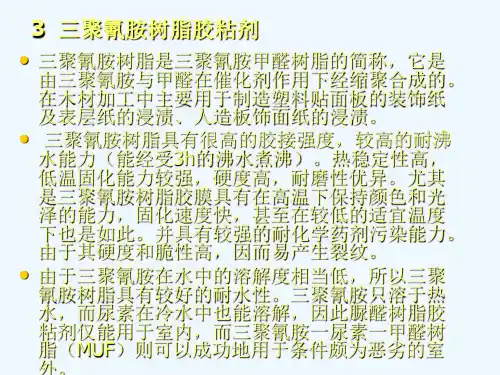
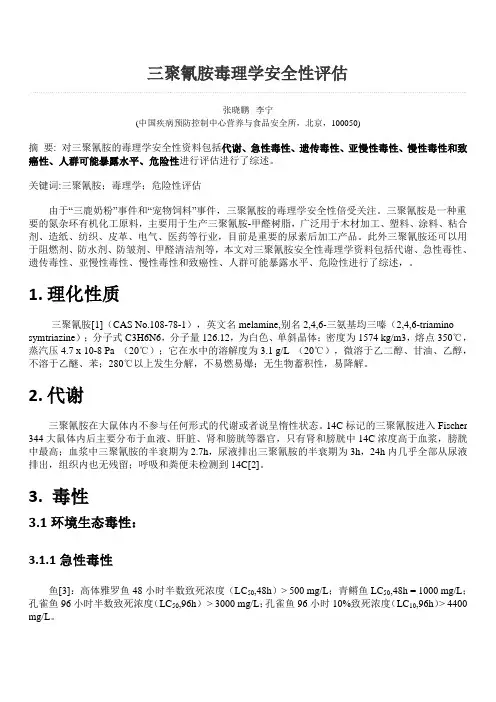
三聚氰胺毒理学安全性评估张晓鹏李宁(中国疾病预防控制中心营养与食品安全所,北京,100050)摘要: 对三聚氰胺的毒理学安全性资料包括代谢、急性毒性、遗传毒性、亚慢性毒性、慢性毒性和致癌性、人群可能暴露水平、危险性进行评估进行了综述。
关键词:三聚氰胺;毒理学;危险性评估由于“三鹿奶粉”事件和“宠物饲料”事件,三聚氰胺的毒理学安全性倍受关注。
三聚氰胺是一种重要的氮杂环有机化工原料,主要用于生产三聚氰胺-甲醛树脂,广泛用于木材加工、塑料、涂料、粘合剂、造纸、纺织、皮革、电气、医药等行业,目前是重要的尿素后加工产品。
此外三聚氰胺还可以用于阻燃剂、防水剂、防皱剂、甲醛清洁剂等,本文对三聚氰胺安全性毒理学资料包括代谢、急性毒性、遗传毒性、亚慢性毒性、慢性毒性和致癌性、人群可能暴露水平、危险性进行了综述,。
1. 理化性质三聚氰胺[1](CAS No.108-78-1),英文名melamine,别名2,4,6-三氨基均三嗪(2,4,6-triamino symtriazine);分子式C3H6N6,分子量126.12,为白色、单斜晶体;密度为1574 kg/m3,熔点350℃,蒸汽压4.7 x 10-8 Pa (20℃);它在水中的溶解度为3.1 g/L (20℃),微溶于乙二醇、甘油、乙醇,不溶于乙醚、苯;280℃以上发生分解,不易燃易爆;无生物蓄积性,易降解。
2. 代谢三聚氰胺在大鼠体内不参与任何形式的代谢或者说呈惰性状态。
14C标记的三聚氰胺进入Fischer 344大鼠体内后主要分布于血液、肝脏、肾和膀胱等器官,只有肾和膀胱中14C浓度高于血浆,膀胱中最高;血浆中三聚氰胺的半衰期为2.7h,尿液排出三聚氰胺的半衰期为3h,24h内几乎全部从尿液排出,组织内也无残留;呼吸和粪便未检测到14C[2]。
3. 毒性3.1环境生态毒性:3.1.1急性毒性鱼[3]:高体雅罗鱼48小时半数致死浓度(LC50,48h)> 500 mg/L;青鳉鱼LC50,48h = 1000 mg/L;孔雀鱼96小时半数致死浓度(LC50,96h)> 3000 mg/L;孔雀鱼96小时10%致死浓度(LC10,96h)> 4400 mg/L。

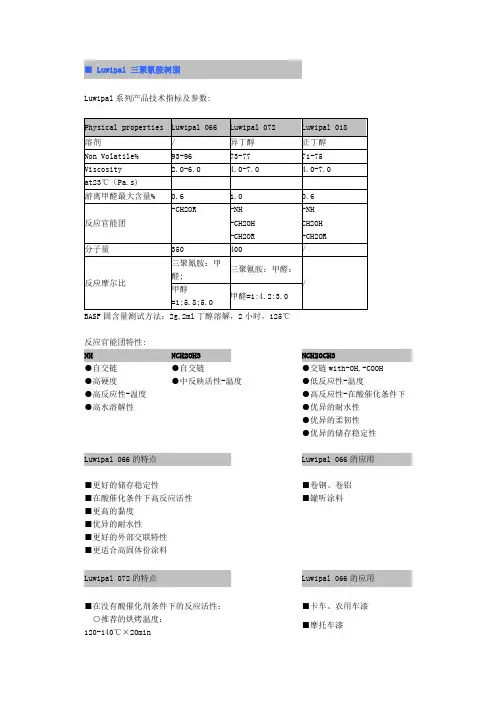
■ Luwipal 三聚氰胺树脂
Luwipal系列产品技术指标及参数:
BASF固含量测试方法:2g,2ml丁醇溶解,2小时,125℃
反应官能团特性:
NH NCH2OH3NCH20CH3
●自交链●自交链●交链with-OH,-COOH
●高硬度●中反映活性-温度●低反应性-温度
●高反应性-温度●高反应性-在酸催化条件下●高水溶解性●优异的耐水性
●优异的柔韧性
●优异的储存稳定性Luwipal 066的特点Luwipal 066的应用
■更好的储存稳定性■卷钢、卷铝
■在酸催化条件下高反应活性■罐听涂料
■更高的黏度
■优异的耐水性
■更好的外部交联特性
■更适合高固体份涂料
Luwipal 072的特点Luwipal 066的应用
■在没有酸催化剂条件下的反应活性:■卡车、农用车漆○推荐的烘烤温度:
■摩托车漆
120-140℃×20min
○最低的烘烤温度:110℃×20min■自行车漆
■最高的涂膜硬度■办公家具
■高光泽■一般金属涂料■优异的水溶解性
■储存稳定性好
■优良的流动性能■汽车涂料
■更适合固体份涂料。

三聚氰胺树脂什么是三聚氰胺树脂?三聚氰胺树脂是一种特殊的树脂材料,也被称为蜂窝脂。
它是由三聚氰胺(C3H6N6)和甲醛(HCHO)制成的聚合物。
在制备过程中,三聚氰胺与甲醛反应形成聚合物,并通过热固化形成树脂。
三聚氰胺树脂具有优异的物理性能和化学稳定性,被广泛应用于建筑、家具、电子和汽车等领域。
三聚氰胺树脂的特性和优势1. 优异的机械性能三聚氰胺树脂具有出色的机械性能,包括高强度、高硬度和优良的耐磨性。
这使得三聚氰胺树脂在制造高负载、高强度的产品方面非常有优势。
例如,它常用于生产家具和厨房台面等需要承受重压和磨损的产品。
2. 耐化学性三聚氰胺树脂具有良好的耐化学性能,能够抵抗酸、碱和溶剂等多种腐蚀物质的侵蚀。
这使得三聚氰胺树脂在化学实验室、医疗设备和电子器件等领域得到广泛应用。
3. 耐热性能三聚氰胺树脂具有出色的耐高温性能,能够在高温条件下保持稳定的性能。
它的玻璃化转变温度通常在150°C以上,因此适用于高温环境下的使用,例如汽车引擎零部件和电子器件的封装。
4. 耐湿性三聚氰胺树脂具有优异的耐湿性能,能够长时间保持稳定的表面性能。
即使在潮湿的环境中,它也能保持优异的物理性能和外观。
这使得三聚氰胺树脂在湿度较高的环境中得到广泛应用,例如浴室家具和室外设备。
5. 可加工性三聚氰胺树脂具有良好的可加工性,可以通过注塑、挤出和压制等多种加工工艺制成各种形状和尺寸的产品。
这使得三聚氰胺树脂在生产过程中更加灵活和高效。
三聚氰胺树脂的应用领域1. 家具制造三聚氰胺树脂广泛应用于家具制造领域,例如制作厨房台面、办公桌和橱柜等。
其高强度和耐磨性使得家具更加耐用,并且能够承受日常使用中的冲击和刮擦。
2. 建筑材料三聚氰胺树脂被广泛应用于建筑材料领域,例如地板、墙板和门等。
其耐热性能和耐湿性能使得它适用于室内和室外的各种环境。
3. 电子器件三聚氰胺树脂在电子领域中有重要的应用。
它可用于电子封装材料、PCB衬底和显示屏等。
三聚氰胺物化性质
三聚氰胺(cyanuramide),分子式C3H6N6。
又称蜜胺、2 ,4 ,6- 三氨基-1,3,5-三嗪。
白色单斜棱晶
熔点345℃(分解),密度1.573克/厘米3 (16℃)。
微溶于水和热乙醇。
工业上三聚氰胺由双氰(酰)胺与氨在高温下反应或由尿素直接在高温高压下制得,后者成本低,较多采用,三聚氰胺与甲醛缩合可制得三聚氰胺甲醛树脂,此外三聚氰胺也用作合成药物的中间体。
产品用途
三聚氰胺是一种重要的有机化工中间产品,主要用来制作三聚氰胺树脂,具有优良的耐水性、耐热性、耐电弧性、优良阻燃性。
用途:可用于装饰板的制作,用于氨基塑料、粘合剂、涂料、币纸增强剂、纺织助剂等。
化学性质
三聚氰胺呈弱碱性(pKa=8),可与多种酸反应生成三聚氰胺盐。
遇强酸或强碱水溶液水解,胺基逐步被羟基取代,先生成三聚氰酸二酰胺,进一步水解生成三聚氰酸一酰胺,最后生成三聚氰酸
毒性
目前三聚氰胺被认为毒性轻微,大鼠口服的半数致死量大于3克/公斤体重。
据1945年的一个实验报道:将大剂量的三聚氰胺饲喂给大鼠、兔和狗后没有观察到明显的中毒现象。
动物长期摄入三聚氰胺会造成生殖、泌尿系统的损害,膀胱、肾部结石,并可进一步诱发膀胱癌。
然而,2007年美国宠物食品污染事件的初步调查结果认为:掺杂了≤6.6%三聚氰胺的小麦蛋白粉是宠物食品导致中毒的原因,为上述毒性轻微的结论画上了问号。
但为安全计,一般采用三聚氰胺制造的食具都会标明“不可放进微波炉使用”。